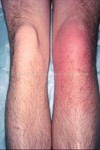Skin and Soft Tissue Infections Flashcards
What is impetigo?
Superficial skin infection
Describe the character of impetigo skin lesions?
- Multiple vesicular lesions on erythematous base
- Golden crus highly suggestive of this diagnosis
What is impetigo most and least commonly due to?
Most commonly due to staph aureus, least commonly due to strep pyogenes
What infection is this?

Impetigo
Who does impetigo commonly infect?
Commonly affects children, is highly infectious
What are some risk factors for impetigo?
- Skin abrasions
- Minor trauma
- Burns
- Poor hygiene
- Insect bites
- Chickenpox
- Eczema
- Atopic dermatitis
What is the treatment of impetigo?
- Small area
- Topical antibiotics alone
- Large area
- Topical treatment and oral antibiotics (such as flucloxacillin)
What is erysipelas?
Infection of the upper dermis
What is the presentation of erysipelas?
- Painful, red area (no central clearing)
- Associated fever
- Regional lymphadenopathy and lymphangitis
- Typically has distinct elevated borders
What is erysipelas most commonly due to?
Most commonly due to strep pyogenes
What infection is this?

Erysipelas
Where does erysipelas mostly affect?
Mostly affects lower limbs, then face
What is cellulitis?
Diffuse skin infection involving deep dermis and subcutaneous fat
What is the presentation of cellulitis?
- Spreading erythematous area with no distinct borders
- Fever is common
- Possible source of bacteraemia
What are the most likely organisms that cause cellulitis?
Most likely organisms are strep pyogenes and staph aureus
What infection is this?

Cellulitis
What are risk factors for cellulitis?
- Diabetes
- Tinea pedis
- Lymphoedema
What is the treatment for erysipelas?
- Combination of anti-staph and anti-strep antibiotics
- In extensive disease, admission for IV antibiotics
What is the treatment of cellulitis?
- Combination of anti-staph and anti-strep antibiotics
- In extensive disease, admission for IV antibiotics
What are examples of hair associated infections?
- Folliculitis
- Furunculosis
- Carbuncles
What is folliculitis?
Circumscribed, pustular infection of a hair follicle
Describe the character of folluculitis lesions?
- Small red papules
- Up to 5mm in diameter
- Central area of purulence that may rupture and drain
- Typically found on head, back, bum and extremities
What infection is this?

Folliculitis
What is the most common organism causing folliculitis?
Staph aureus
What is the treatment for folliculitis?
- No treatment or topical antibiotics
What is furunculosis?
Single hair follicle associated inflammatory nodule extending into dermis and subcutaneous tissue
What is furunculosis commonly refered to as?
Boils
Describe the character of furunculosis lesions?
- Usually affects moist, hairy, friction prone areas of body
What infection is this?

Furunculosis
What organism most commonly causes furunculosis?
Staph aureus
What are risk factors for furunculosis?
- Obesity
- Diabetes
- Atopic dermatitis
- CKD
- Corticosteroid use
Are systemic symptoms with furunculosis common?
- Systemic symptoms uncommon
What is the treatment of furunculosis?
- No treatment or topical antibiotics
- If not improving oral antibiotics
What is carbuncle?
Occurs when infection extends to involve multiple furuncles
Describe the character of carbuncle lesions?
- Often located back of neck, posterior trunk or thigh
- Multiseptated abscesses
Are systemic symptoms common with carbuncle?
- Systemic symptoms common
What infection is this?

Carbuncle
What is the treatment for carbuncle?
- Surgery
- IV antibiotics



